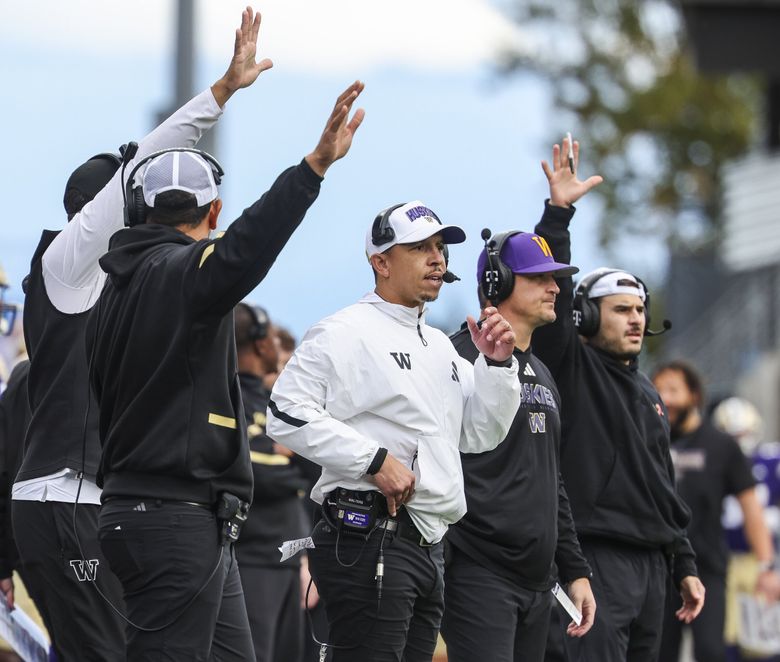How UW’s defense transformed into one of the Big Ten’s best

Like we said on the pod… Kudos to Jedd Fisch for hiring Walters instead of Bill Parcells' brother-in-law or whatever.
Washington defensive coordinator Ryan Walters, center, and his staff watch as the Huskies try to put a red zone stop on Illinois in the fourth quarter, Oct. 25, 2025 at Husky Stadium in Seattle. (Dean Rutz / The Seattle Times)
By Andy Yamashita Seattle Times staff reporter
Ryan Walters came to Washington with a reputation and a recipe for defensive success. Five-down defensive fronts. Heavy doses of man-to-man coverage. Lots of Cover 2 when playing zone defense.
Those are the principles that made him one of the nation’s best defensive coordinators at Illinois. That helped him become one of the country’s youngest head coaches when Purdue hired him before the 2023 season.
But Walters, as he’s continually emphasized since being hired as Washington’s defensive coordinator in January, isn’t the same coach he was at his previous stops. And this season, Walters has demonstrated an attribute he’s not particularly known for as a coordinator and play caller: Flexibility.
“I think a lot of times, coaches get wrapped up and get stubborn in trying to get guys to fit their philosophy,” he said Tuesday. “And to me, those roles should be reversed. It should be our job to adapt to them to put them in advantageous situations that heighten the things they’re good at.”
Walters’ defense has been productive through 10 games. The Huskies have allowed 19.3 points per game, 20th nationally. They haven’t conceded more than 25 points in any game this season, something they did five times under former defensive coordinator Steve Belichick in 2024. Walters said the team’s success has been the result of his players’ commitment and the coaching staff’s willingness to adjust.
“It’s been like a marriage,” he said. “A mutual adaptation between what, as a staff, you think you want to do philosophically and schematically, and what the guys are capable of and what their skill sets are.”
Advertising Skip AdSkip AdSkip Ad
Walters said the most notable change he’s made has been deploying more Cover 3 zone defense. The scheme gets its name because the deep part of the field is divided into thirds, but it also allows a safety — usually junior Alex McLaughlin, UW’s team leader in tackles — to remain near the tackle box, a key principle of Walters’ defenses at Illinois.
With one safety, two linebackers and a nickel closer to the line of scrimmage, Cover 3 is often associated with being better against the run. The extra defender also means the defense is less reliant on dominant defensive line play to stop an opponent’s rushing game.
Additionally, Cover 3 has a simpler gap scheme against the run because it requires each second-level player to cover only one gap. That makes it easier to learn for younger linebackers — like freshman standout Zaydrius Rainey-Sale, for example.
Walters said the decision to pivot toward more Cover 3 stemmed from the personnel at his disposal and the run-heavy offenses Washington has faced in the Big Ten. He added that he’s enjoyed experimenting with a scheme he hasn’t typically utilized much in the past.
“We’re a lot of Cover 3 this year, so that’s been fun for me, personally,” Walters said. “Just to continue to grow, get creative, different types of pressures, different types of man and zone pressures, it’s been a fun year of growth.”
Perhaps paired with Washington’s aptitude for Cover 3, Walters has also gone away from the five-down defensive fronts he was known for at Illinois.
Advertising Skip Ad
Fifth-year defensive lineman Simote Pepa, the Utah transfer who emerged as Washington’s top choice at nose tackle in its five-down defensive front during fall camp, has seen his defensive snaps plummet since the start of the season.
After playing at least 10 snaps during each of UW’s first three games, according to Pro Football Focus, Pepa, a 6-foot-3, 350-pound defensive tackle, has reached the 10-snap mark just once since conference play started — an 11-snap appearance during Washington’s 24-7 defeat at Michigan Oct. 18.
He played just two snaps against a Wisconsin team that essentially did not have a passing game because it cycled through three quarterbacks and ended the game with a punter as its leading passer. And against Purdue on Saturday, Pepa played only a single snap.
Similarly, sixth-year nose tackle Logan Sagapolu has played just 19 defensive snaps all season after returning from an undisclosed injury that held him out of the first two games. The 6-2, 348-pound Sagapolu also played just two snaps against Wisconsin and one against Purdue.
Pepa and Sagapolu are listed as the heaviest players on Washington’s roster, but the Husky run defense has held up without them. Washington is giving up only 109.8 yards rushing per game in Big Ten play. Only No. 1 Ohio State, No. 2 Indiana and No. 18 Michigan are allowing fewer yards rushing per game since the conference season started.
“The biggest thing has been our adjustment as a staff,” he said, “to what they’re good at and what their strengths and weaknesses are.”
Of course, Walters’ decision to play more Cover 3 and move away from five-down defensive fronts wasn’t instantaneous. It was an evolution, dictated by the Washington defensive staff as it tried to find the best situations for its available personnel. A metamorphosis, of sorts.
“Over the course of the year,” Walters said, “we’ve sort of morphed into what we’re doing now, defensively, because that’s what has allowed them to have more success.”
Andy Yamashita: ayamashita@seattletimes .com. Andy Yamashita is a sports reporter at The Seattle Times, primarily covering Washington Huskies football.
Comments
-
If Jedd had PGOS at OC this team is undefeated
-
Thanks Taft!



